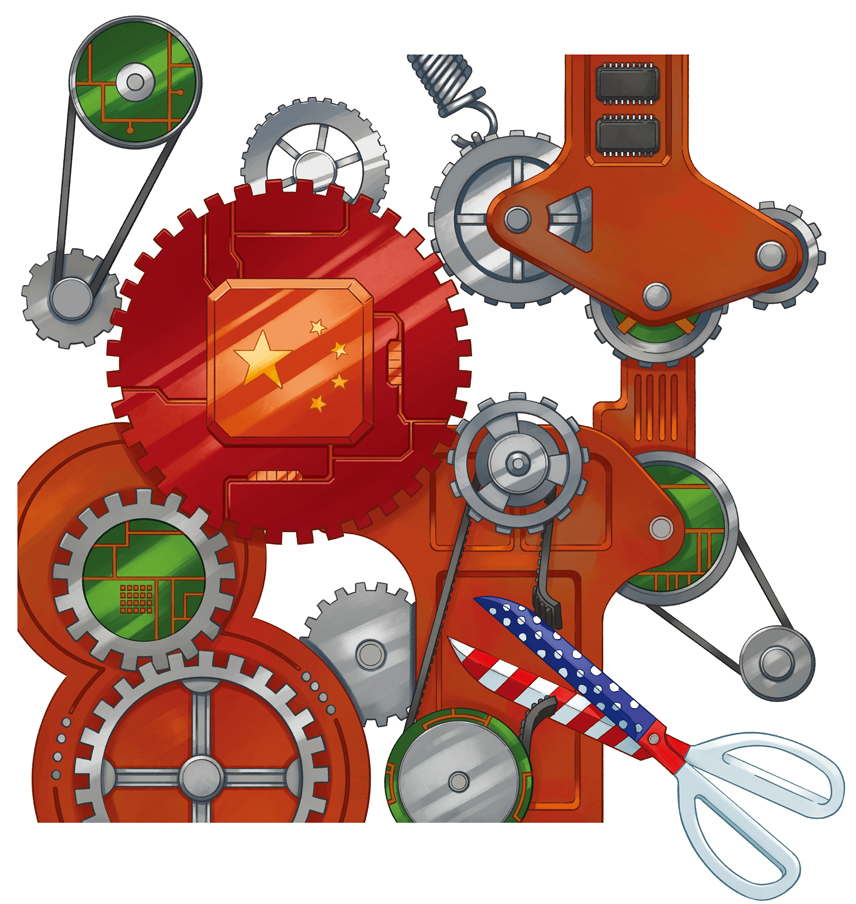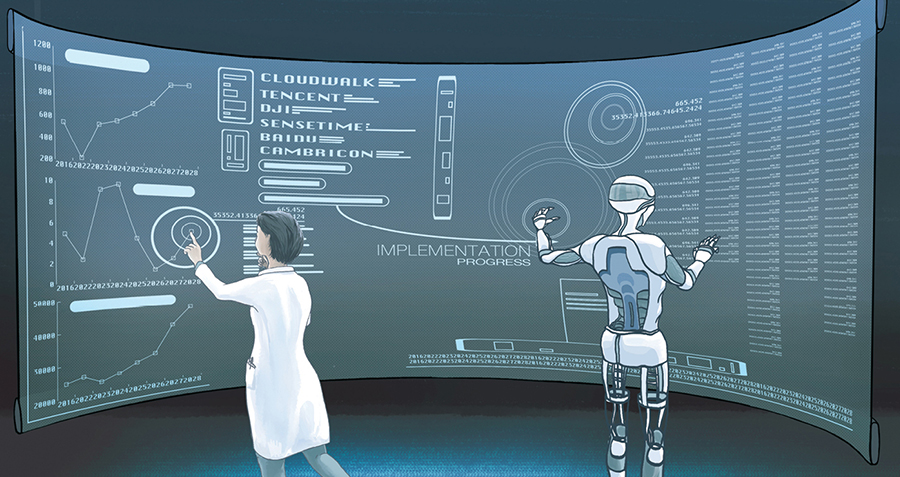The dawn of the Internet of Things (IOT) era may finally be upon us. For almost a decade, the concept has been hailed as the next game changing technological innovation, and while the principles behind this idea have always been sound, it has so far yet to manifest as a commercial reality.
The concept remains widely misunderstood, particularly as definitions of its scope vary widely. McKinsey & Company defines IOT as follows: “In what’s called the Internet of Things, sensors and actuators embedded in physical objects—from roadways to pacemakers—are linked through wired and wireless networks, often using the same Internet Protocol (IP) that connects the Internet.”
Towards a Chinese IOT
In China, the government’s advocacy for the domestic development of the IOT industry has been more fervent than most, in part due to the administration’s previous failure to invest in basic internet structures, and later its concerted but ultimately unsuccessful attempt to inspire an international take-up of its domestically developed 3G networks.
“The Chinese government does indeed appear very serious about promoting IOT development as a national policy objective,” says Kurt Tiam, a Senior Associate with law firm Hogan Lovells in Beijing. “There have been statements from top officials to this effect, and policy documents such as the 12th Five-Year Plan on the IOT further support the view that the central government sees the growth of the IOT space as a priority.”
The numbers are impressive, with the Ministry of Industry and Information Technology (MIIT) estimating the market’s value will rise to more than RMB 500 billion ($82.1 billion) by 2015, and RMB 1 trillion by 2020.
As it stands, the state remains very firmly in the driving seat when it comes to providing financial support and engineering opportunities to invest in and provide technology for projects that leverage IOT technologies.
“The Chinese government is by far the largest consumer in the IOT space. Consequently, the government has tremendous leverage in shaping the industry’s development,” Tiam adds. “That said, a lot of the action remains at the local level, as certain local governments have been particularly active in promoting the development of the IOT industry.”
Moreover, a glance at the list of projects financed under the central government’s RMB 500 million per year Special Fund for IOT Projects reads like an index to sectors considered of paramount importance to both central and local government in China.
For example, the 2012 lists includes, amongst others, a project developing high pressure and temperature RFID sensors to provide safety warnings in oil drilling projects, bridge and other structural safety monitoring systems, data mining software for urban traffic systems, energy demand management systems, as well as a variety of sensor-based food and drug safety tracking and storage management projects. The 2013 list is notable for a shift in emphasis towards systems aimed at monitoring public security, including real-time image recognition software, while retaining a strong focus on various logistical applications.
Many of these special projects are based in the National Sensor Information Center (NSIC) in Wuxi, Jiangsu Province, which is chief among the local governments backing IOT development. The park boasted nearly RMB 80 billion in IOT industry output as of August 2012, and is now reputedly home to near 1,000 companies working on IOT-related projects.
“The whole IOT industry chain has been developed here, from sensor chips to model applications, systems and the big demonstration projects,” says Sammy Shen, Vice-President of Business Development at the NSIC’s Sensing China Center.
“In phase one the government has an obligation to lead the industry and attract more companies into the market. That’s why the government has provided all kinds of funding for national demonstration projects,” he says, adding that part of his role is to help connect potential clients with companies operating in the NSIC.
At the start of November, the National Development and Reform Commission (NDRC) released a circular stating it will encourage (usually through a package of financial incentives) local governments to implement such demonstration projects across manufacturing, agriculture, environmental protection, commerce and distribution, transportation and energy, public safety, social undertakings, urban management, and production safety. The circular says encouragement should take the form of government departments, and state-owned enterprises, purchasing IOT applications, particularly those that serve to “enhance production and operation efficiency, facilitate energy conservation and emission reduction, and improve the level of production safety.”
Such massive projects provide an ideal test market, but the government is wary of the dangers of excess investment, according to Shen. “Phase two, and this is when we can judge whether it is really a true market, will be when more companies invest their own money, when it becomes money-making, profitable and is demand-led,” he explains, adding that he is not worried about near-term enterprise failure because Premier Li Keqiang has reinforced Beijing’s backing for the IOT, and the State Council has signed off an eight-year (2012 to 2020) plan for the NSIC itself. In fact, various IOT hubs, including Wuxi and Shanghai, have been set IOT output targets for 2015 under the 12th Five-Year Plan, and the NDRC’s action plan specifically aims to spur development through to the end of 2015 as well.
Prohibitive Costs
IOT-related technologies are already making an impact across a broad scope of business in China. So-called smart home appliances have long been heralded as the next breakout sector for IOT, allowing consumers to remotely control water heaters, air conditioning units or stereo systems via a command center on their mobile phone, but prohibitive costs have stymied the commercial development of the technologies.
“Consumer applications alone do not justify the cost of development. That’s why smart homes didn’t take off even after 20 years of effort,” says Randy Zhou, author of the book ‘The Internet of Things in the Cloud’, and current GM of Foton Fleet Telematics and a board director at Qingdao Haier.
“Now people are finding it useful from the point of view of management and maintenance. One aspect is to provide functionality to the consumer, but the other side is for the manufacturers–they want the appliances connected because they can glean a lot of insight from the connectivity that will justify the cost.”
Zhou notes that information on product distribution density, lifecycle maintenance and other verticals can prove invaluable when making investment decisions, and this aspect is integral to his role at Haier. Other home appliance makers such as Bosch are also well advanced in the sector.
Such home connectivity does not require advanced sensor networks to implement, with existing standards such as Wi-Fi or ZigBee suitable for linking products. Indeed, at the end of October, LG, Cisco, Bosch and ABB signed a global memorandum of understanding to develop an open standard for software to control smart home appliances, supporting standards including Wi-Fi and Zigbee, allowing the devices they produce to be integrated into home control systems.
In this respect, the absence of an accepted domestic or international IOT industry communication standard does not put a brake on development of short-range technologies.
However, the same cannot be said for long-distance applications. Henry Gong, formerly a consultant to Intel China and now pioneering his own IOT start-up in Beijing that sells solutions integrating products from the likes of GE to domestic Chinese clients, is currently working on a landmark project to install sensor networks along the 4,000 km-long West-East gas pipeline that will eventually bring gas sourced from Kazakhstan to various cities on China’s eastern seaboard.
“We use sensors to gather data on pressure in the pipeline and data on the temperature in the compressor, as well as the working status of the compressor and accessories,” Gong says, adding this information is then sent to a central command center, enabling the pipe operator to lower maintenance and staffing costs.
“Right now we use fiber optics [to transmit the data] because there is no affordable wireless method or channel for such a very long distance. It’s very difficult. In the future they are thinking about a wireless method – but the wireless tech is not ready for deployment, I could only use 2G or 3G mobile over such a long distance, but building the base stations is a big expense, even 4G is too costly compared with fiber optics.”
That situation is likely to change once China’s government frees up frequencies used by analogue TV (known as ‘white space’) for use by IOT applications, a process already completed in the US and well underway in the UK, and one which Gong estimates could cut costs relative to 3G and other mobile standards in half.
“The majority of machine-to-machine (M2M) and smart city technologies are using 3G because it is there, but it’s not ideal,” adds Alan Woolhouse, Chair of the Marketing Working Group at the UK’s Weightless SIG, a non-profit promoting the creation and adoption of a proprietary open wireless technology standard for machines to exchange data around a base station via ‘white space’ frequencies.
In the meantime, M2M networks have been proliferating in China anyway, with the number of terminals growing to 34 million in 2012, up 50% on the year, primarily across smart grid and transport applications, according to the MIIT’s China Academy of Telecommunications Research.
China’s telecom companies are also actively engaged, with China Mobile having signed agreements to construct wireless smart cities with 217 cities nationwide, with projects ranging from live traffic management to remote fire safety systems. China Telecom and China Unicom have each signed more than 100 contracts with cities around the country, according to the academy’s data.
“Every city has its own ‘smart city’ policy,” notes Zhou. “Beijing is particularly advanced. I have advised on a project to build a system to connect all the sub systems for transport and the environment, the Public Security Bureau and utilities–connecting everything to the cloud.”
Zhou is also keen to stress that the disparate nature of IOT projects and implementation has resulted in a fragmented market with lots of opportunity.
“Every city has its own projects and its own companies working on them–the wealth is shared, not like the internet, which is dominated by a handful of massive companies. There is no concentration of the wealth in one company because the business model is so different from the web.”
Logistics Spearheading Adoption
Understanding that difference is also crucial to understanding why security of IOT systems is not the bugbear some have made it out to be.
“It often gets exaggerated–the security issue. There’s ownership and protection, and not all of the systems will be public. For example with the telematics, you wouldn’t let just anybody have access to the traffic system and change the traffic lights,” Zhou explains. “IOT systems are like having money in the bank–not everybody is going to see it. So unless you believe that your bank account cannot be protected, there is no security issue.”
Zhou maintains that the take-up of IOT technologies is not “mission critical” for many industries, but instead will progress like the adoption of email, becoming increasingly indispensable as time goes on. However, logistics companies are an exception, as the savings they can make through Big Data management are just too big to be ignored.
“For vehicle fleet management for companies like Caterpillar, it is mission critical to get their fleet connected: bulldozers, cranes are expensive pieces of equipment to run and they are normally leased to the constructor. So if they don’t heed the lease, or the equipment is misused or stolen, they can remotely disable the equipment,” he says. “They can track the fleet, they know details on usage, fuel consumption and maintenance requirements, and this enables them to accurately calculate the remaining value of the vehicle and insurance costs.
Drawing a bigger picture, Zhou notes that such data would be invaluable for investors across a range of sectors, as real data on construction vehicle activity in China would provide a viable alternative to China’s Purchasing Managers Index and other economic indicators.
Open Sector?
One salient point that needs to be addressed is how accessible this burgeoning market will be for overseas technology companies. “The fact that China’s IOT development is so deeply influenced by the state does not mean that foreign entrants will be left out in the cold,” notes Hogan Lovell’s Tiam. “Given the importance of technological development and expertise in this space, players with the desired know-how should theoretically be welcomed in China. In order for China to take advantage of the benefits such players can bring, however, the authorities will have to significantly soften their stance against foreign participation in the internet and telecommunications sectors. Domestic private entities also face challenges in making an impact on China’s IOT space given that the IOT industry in China is currently dominated by large state-owned enterprises and multinational companies which tend to have strong, established relationships with local and central government officials.”
“There is a huge market for middleware integrating the systems of firms like IBM and Cisco so they can sell into China and worldwide,” agrees Zhou. “A year ago there were people talking about it but the big US companies did not move on it, it was mostly just the EU and China government. Starting this year we are starting to see a lot of action at the big US companies.
Looking ahead, the State Council in February called for the achievement of “applications of Internet of Things in key areas by 2015”, which the NSIC’s Shen sees as a critical timeline for the emergence of how China’s ‘smart city’ plans are being implemented and which companies are most prominently involved.
“We already have cooperation with big international companies. I’ve worked with IBM, Microsoft, Cisco, Samsung and other leading multinationals, Siemens, Bosch, Microsoft are also in Wuxi,” Shen says, adding that IBM is involved with about 200 ‘smart city’ projects nationwide in China.
However, following Edward Snowden’s revelations regarding US technology firms’ complicity with the National Security Agency (NSA) on data sharing, there are widespread fears that the Chinese government will react by blocking overseas firms’ access to systems which effectively control how they manage their urban infrastructures.
During Cisco System’s most recent earnings call on November 13, Chairman and CEO John T. Chambers specifically referenced China’s “challenging political dynamics” as part of the reason for a sharp fall in sales in the country, and specifically acknowledged that the NSA revelations were having an impact.
As such, just as the cost barriers associated with implementing the IOT in China and around the world appear to be being surmounted, the market’s next battleground is shaping up to be a political rather than technological one.

















